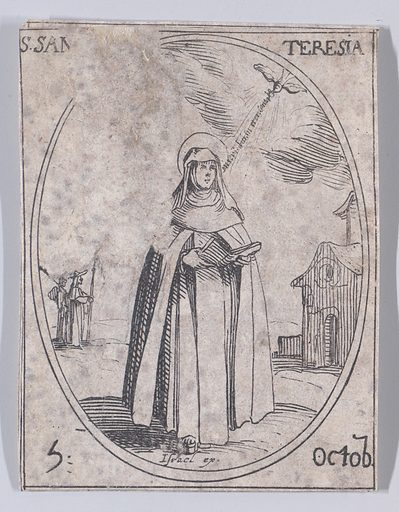by Carol Dixon
I was first introduced to St Teresa of Avila (whose saint’s day falls on 15 October) in the 1990s when our church got a new hymnbook ‘Rejoice and Sing’ and one of the new hymns in it had the words attributed to her which I really loved. It began ‘Nothing distress you, nothing affright you, everything passes, God will abide.’ I didn’t realise at the time that it was an English version of the beautiful Taize chant ‘Nada de turbe’.
The thing I really like about the hymn is that the writer Colin Thompson cleverly weaves the words of the first verse into each of the following verses – for example verse 2 says: ‘Lift your mind upward, fair are his mansions, nothing distress you, cast fear away’ and the other verses do the same with the rest of the words. The tune ‘Many mansions’ by Peter Cutt is lovely too and is a reminder of the wonderful reassuring words of Jesus from John’s Gospel Ch 14 verse 2 – ‘In my Father’s house are many mansions: if it were not so, I would have told you. I go to prepare a place for you.’ (You can listen to it on YouTube by typing in ‘Nothing Distress you‘ – played by the organist of St James’s URC, Newcastle, the church I used to work in as Moderator’s Secretary in Northern Synod)
I then discovered that Teresa also wrote the prayer “Christ has no body now but yours. No hands, no feet on earth but yours. Yours are the eyes through which he looks compassion on this world. Yours are the feet with which he walks to do good. Yours are the hands through which he blesses all the world. Yours are the hands, yours are the feet, yours are the eyes, you are his body. Christ has no body now on earth but yours”. I have wrestled with these words for many years, feeling the great weight of responsibility of actively working for Christ in the world. So who was this interesting woman who wrote such comforting and challenging prayers?
According to a Roman Catholic website for young people, Teresa was born in 1515 near Avila in northern Spain, the third of nine children. When she was thirteen, her mother died and her father decided to send her to be educated at the Augustinian convent but after two years she became ill and was sent home. Later she expressed a wish to become a nun but her father refused permission so she secretly left home to join the local Carmelite Convent of the Incarnation, a community of 140 nuns who prayed together and privately each day. Each nun had a set of rooms (a bedroom, a small kitchen, and a guest room), guests could come and go freely and nuns could leave the convent to visit friends and relatives. Some of them even had maids! Teresa made her solemn profession as a Carmelite nun, and for the next twenty years she lived at the convent. But in the busy convent, she found meditation and prayer difficult.

View from the Convent of St Teresa, Avila [ Photo by Wei Hunag on Unsplash]
Her attitude towards God changed in 1555, when she was meditating on the gospels and Christ’s sufferings and wanted to return the love shown by Jesus in her own life, realising that the environment of the convent kept her from a serious life of prayer. She began to dream of a small, poor, and fervent Carmelite monastery where the nuns could support one another in their common love of God. “We need no wings to go in search of Him, but have only to look upon Him present within us,” she wrote. With four companions who shared her views, Teresa founded the Order of Discalced Carmelites (Discalced means “shoeless”). Teresa founded 16 monasteries for women, travelling long journeys by donkey through every kind of terrain and weather. She became known to the people of Spain as “the roving nun.” Teresa had always enjoyed people, and many came to her or wrote to her for her advice. On feast days, she played the tambourine so that the nuns could sing and dance. Teresa wrote several books including The Interior Castle, an imaginary journey into the soul via different ‘rooms’ in a castle, The Way of Perfection, and an autobiography. Her teachings were based on her own lived experience, and were rooted in the Scriptures, especially the Gospels.

St Teresa with her book
My own favourite writings of hers are her prayers. Here are a few of them:
Lord, grant that I may always allow myself to be guided by You,
always follow Your plans, and perfectly accomplish Your Holy Will.
Grant that in all things, great and small,
today and all the days of my life,
I may do whatever You require of me.
Help me respond to the slightest prompting of Your Grace,
so that I may be Your trustworthy instrument for Your honour.
May Your Will be done in time and in eternity by me, in me, and through me.
Lord, you are closer to me than my own breath, nearer to me than my hands and feet.
And a wonderful prayer for those of us growing older:
Lord, You know better than I myself
that I am growing older and will someday be old.
Keep me from the fatal habit of thinking
I must say something on every subject and on every occasion.
Release me from craving to straighten out everybody’s affairs.
Make me thoughtful but not moody; helpful but not bossy.
With my vast store of wisdom, it seems a pity not to use it all;
but You know, Lord, that I want a few friends at the end.
Keep my mind free from the recital of endless details;
give me wings to get to the point.
Seal my lips on my aches and pains;
they are increasing, and love of rehearsing them
is becoming sweeter as the years go by.
I dare not ask for improved memory,
but for a growing humility and a lessening cock-sureness
when my memory seems to clash with the memories of others.
Teach me the glorious lesson that occasionally I may be mistaken.
Keep me reasonably sweet, for a sour old person
is one of the crowning works of the devil.
Give me the ability to see good things in unexpected places
and talents in unexpected people;
and give, O Lord, the grace to tell them so.
As I meditated on her wise words I was inspired to write a poem reflecting on what getting older means to me.
Contemplation
Old lady in a garden, resting,
walking stick at her feet,
watching the ripples
On the tiny waterfall
Glinting in the sun;
gentle breeze wafting the bushes,
delicate as filigree;
fuchsias dancing, roses beaming,
and a small bird rooting on
the gravelled path.
Watching at a distance
as a youngster looking on,
I never thought,
one day it would be me.
The prayer for 15 October in my devotional guide ‘28 days with St Teresa of Avila’ says:
‘What wonders we shall see
If we keep before our eyes our frailty and folly,
And recognise
How unworthy we are
To be the servants of so great a Lord,
Whose marvels are beyond our comprehension’’
St Teresa’s greatest prayer ‘Nada de Turbe’ is said to have arisen after she was meditating on the words of St Paul in Philippians 4: 8 ‘Fix your thoughts on what is true and good and right. Think about things that are pure and lovely, and dwell on the fine, good things in others. Think about all you can praise God for and be glad about.’
My friend Revd. Sheila Hamil wrote a beautiful song based on that Bible passage during lockdown and posted it on YouTube. She also shared her thoughts on how it came to be written in the comments.
Here it is with her blessing.
As an Amazon Associate I receive a small amount for purchases made through appropriate links. Thank you for supporting Godspace in this way



